Prologue: Early precursors (1800-1870s)
The invention of the “Torpedo”
While the torpedo was invented only in 1866 by Robert Whitehead, just a year after the end of the Civil War, the prototype was first created in 1863 by the Austro-Hungarian officer Ivan Lupis. Called salvacoste it had many shortcomings that were solved by Whitehead, turning it into a practical weapon. Before that, the “torpedo” named after an electric ray sub-species was essentially a naval mine. A towed gunpowder charge was first tested operationally by Robert Fulton in 1800 with its submarine Nautilus. There were other attempts at mining ships in the war of 1812, and in the Crimean War in 1855.

USS Spuyten Duyvil, US Navy dedicated spar-torpedo vessel, 1863.
Torpedo ships of the American Civil War
The torpedo’s first real impetus came from the American Civil War, in particular in the form of air-filled demijohn and powder charges that exploded on contact, later carried by spars. The spar-torpedo boat became in effect a precursor of the torpedo boat, as the carrier of the spar-based weapon was generally small and fast. That was a dangerous endeavor, a reckless and desperate form of warfare to say the least, and was mainly practiced by the Confederates to try to balance out the huge advantage of the Union navy.
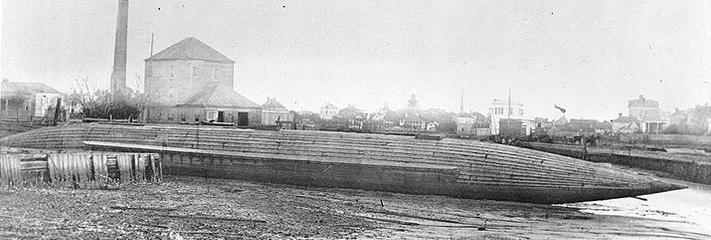
An enlarged CSS David was started, but captured at Charleston in 1865 before completion.
The USS Cairo was sunk in 1862 by such a contact mine. A 30-foot (9.1 m) long spar was also carried by the HL Hunley, the first “submarine” (propelled by a manned crankshaft). Despite sinking twice (with all hands), the innovative boat succeeded in destroying the USS Housatonic.
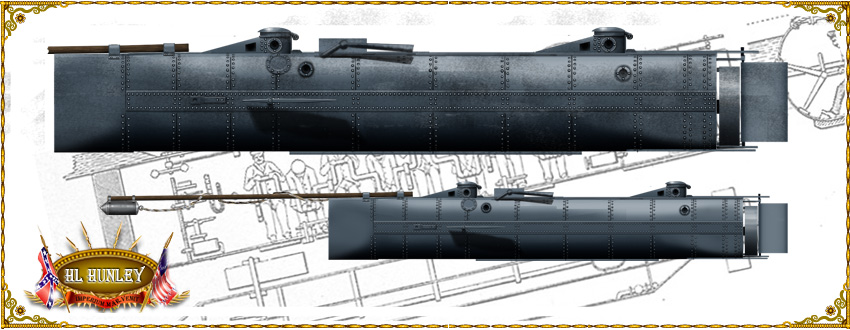
HL Hunley, the most famous Confederate submarine

CSS David, famous Confederate torpedo-ram
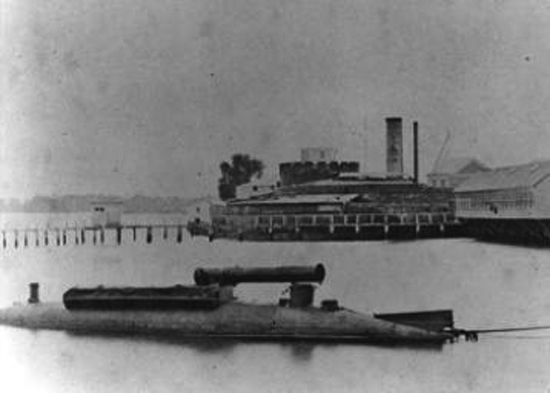
CSS David daguerreotype
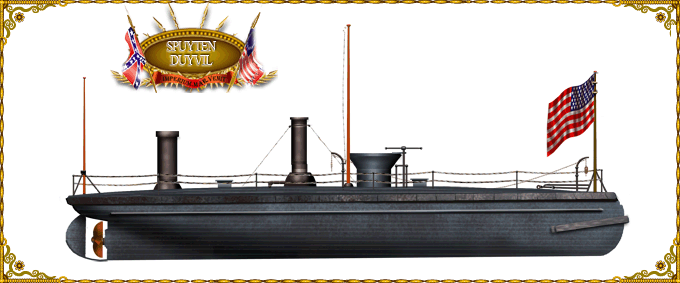
USS Spuyten Duyvil. Despite its overwhelming superiority on the Confederates, the Union navy also built a spar-torpedo boat in 1964.

USS Alligator, 1862. This Union fleet (and first American sub) boat was capable of operating divers, carrying two limpet mines.
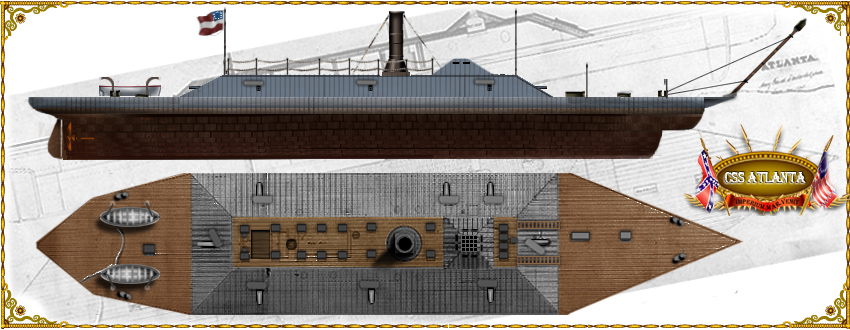
The Confederate river ironclad CSS Atlanta (1863), carrying a spar torpedo at the front.
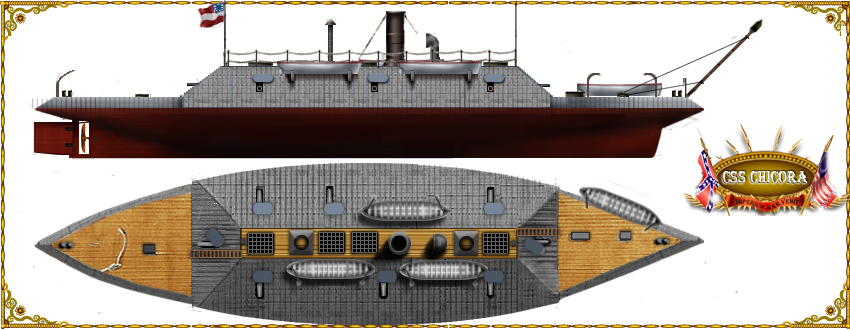
The Confederate river ironclad CSS Chicora (1862), carrying a spar torpedo at the front.
Other ships of the “Old Navy”
After the famous Monitor, the US Navy built other, less-known classes like the Passaic, Miantonomoh, Canonicus, Kalamazoo, Milwaukee, Casco, or the remarkable USS Dictator, a sea-going monster. But other smaller ships had been converted to be used as torpedo rams, notably to destroy Confederate boat barrages on the James River. In addition to the Spuyten Duyvil (see above), two large experimental, iron-hulled ships were also built after the war in 1873, the Alarm and Intrepid. However, both were too slow for their intended role.
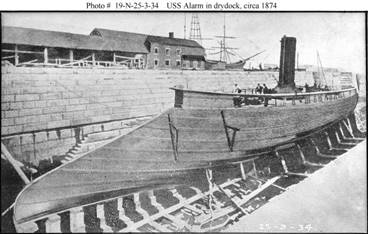
USS Alarm, 1873 spar-torpedo vessel.
Unusual ships of the “New Navy”
Two interesting ships were built in the 1880-90s, one was not torpedo-carrying but experimented with another idea: launching dynamite with pneumatic guns. The USS Vesuvius (we will come back to this very unique design) had three Zalinsky 55 feets pneumatic guns at the front on an open barbette. The projectiles weighed 980 Ibs, with 500 Ibs dynamite warheads.
Launched in 1888, its only action with the not convincing bombardment of Santiago ten years later. However, the USS Katahdin could have been a torpedo ram in the European tradition. Launched in 1893, it had a very sloped hull, cigar-shaped, made up of iron plating backed by wood. But instead of TTs or a spar, she was fitted with four 6-pdr quick-firing guns. Her most interesting feature was that her hull was fitted with ballasts so she could be submerged before ramming.
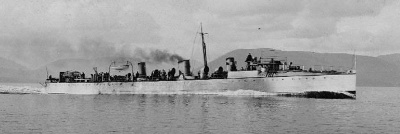
The Spanish destroyer Furor. The American Civil War broke out in 1898, but none of the commissioned TBs were ever put to action due to the distance both of Cuba and the Philippines. They did provide however an harbor coastal defence in the unlikely case of a retaliation by the Spanish Navy on the US Coast.
American Torpedo Boats (1885-1899)
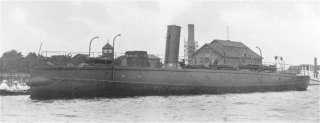
The famous Stiletto was not a very successful boat. Its contemporary namesake is an Experimental stealthy pentamaran capable of 60 knots.
A short lived experiment
For 15 years, the US Navy ventured into this kind of boat, though not without reticence as many in the fleet advocated not for a defensive but more “active” stance on the international scene. Indeed Alfred Thayer Mahan became president of the Naval War College by default in 1886 and befriended future president Theodore Roosevelt in 1888. Both had the same views about the duty of the US Navy. But whatever the case, by 1895 TBs were definitely out of the picture as the first American destroyers, looking more promising, took their place. The move was decidedly towards a “fleet in being”.
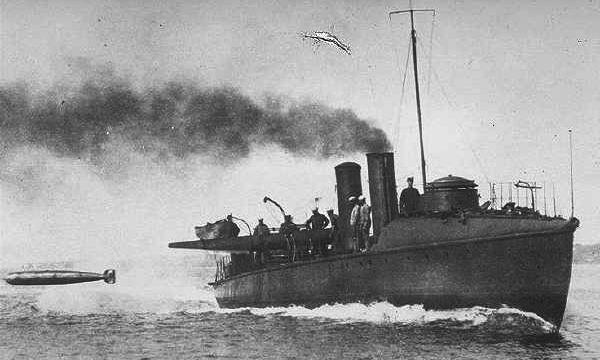
An early USN TB launching a torpedo
US Navy TBs Specifics
There are nevertheless specifics about American TBs. First, most were largely semi-experimental, with gradual improvements on small orders of 2-3 ships. In total, 35 had been built, and many were one-off experiments. The lightest has been the first Stiletto at 31 tons, and the heaviest was the Nicholson series, at 218 tonnes. Their average displacement was about 160 tons. They were fitted with either Thornycroft, Normand, Mosher, or Seabury or locomotive boilers, and used VTE engines (vertical triple expansion) while in rare cases, VQE (Quadruple expansion) engines were used. The fastest was the Dahlgren, at 31 knots, but the average speed was 25 knots.
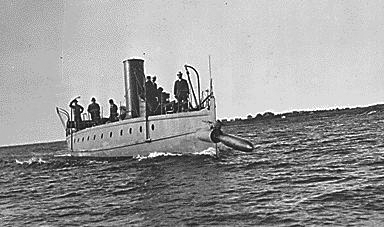
Stiletto, the first American TB, bow-launching a torpedo.
Most ships’ standard armament was composed of two to three 18 in Torpedo Tubes and one to three 1-pdr QF guns. They nearly all presented a front turtleback and some tumblehome all along their hull because of expected North Atlantic rough seas. Their average range however only allowed for short sorties of 50 miles, due to the limited size of the ship’s coal stores, reaching 80 tonnes on the Nicholson.
Shipyards
They were many small shipyards involved, some more than others. The most active in this area was Herreshoff, which turned out seven TBs, including the first one, and later rose to fame as the builder of eight successful defenders of America’s Cup from 1893 to 1934. There is a museum accessible from Providence and Boston.
Bath Iron Works (Kennebec River, Bath, Maine), launched five ships, Columbian Iron Works (Baltimore, Maryland) five, followed by lesser-known yards like Iowa Ironworks (TB2), Moran (TB8), Wolff & Zwicker (TB12-13), Charles Hillman (TB17), George Lawley (TB27-28), Lewis Nixon (T29-30), WR Trigg (TB-31-33), and Gas Engine & Power and CL Seabury (which also built boilers) delivered the very last one, USS Wilkes alias TB35 in 1901.
Only one was delivered by a foreign yard, the world’s famous specialist: Schichau, in 1897, delivered USS Somers, commissioned just a few days before the Spanish-American War.

USS Stiletto, illustration by the author
To simplify things, we will treat these TBs in three series: The “small” and “medium” TBs prior to the Spanish-American war of 1898 and the large post-war models of the Blakely class commissioned up to 1905.
The “light group” 1886-1898
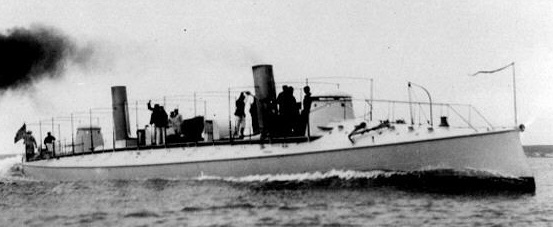
USS Cushing, TB1.
USS Stiletto
The first one was called WTB1 to mark its experimental nature. Laid down at Herreshoff in 1885, launched in 1886, and commissioned in 1887 it was small (28.64 x 3.50 x 0.91m, 31 tons), had a flat deck and ram, but no TT. Instead, it carried two Howell torpedoes, but only from 1898. It was fitted with an Almy boiler coupled with a vertical compound engine that turned a unique shaft, producing 395 ihp for a whopping 18.5 knots. Coal was limited to just four tons and thus the ship was limited to coast. Shortly after its introduction into service, it was stranded ashore after a collision with a steam launch. This was a single funnel, wood-hulled boat that was confined to runs and experimental works. A bad steamer, her 1897 fuel trials were a failure. After being mothballed for some years, she was sold for scrap in 1911
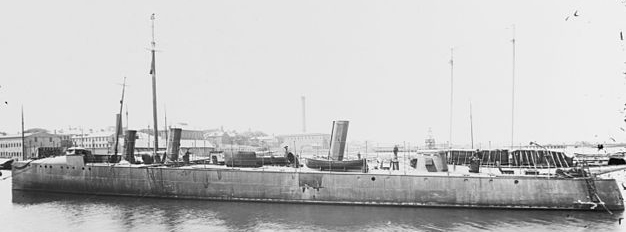
USS De Long.
Coastal TBs of the Talbot & Mackenzie class
Among the smallest American TBs, these two classes (Talbot, Gwin, Mackenzie, McKee) were authorized under the act of 10.6.1896. The first two (Herreshoff) had a single funnel, two single TTs far apart – one front of the funnel, one aft, and were both commissioned in April 1898. The Gwin was later used as a Ferry and was later renamed Cyane in 1914 while USS Talbot was used from 1900 for oil fuel tests and decommissioned in 1925.
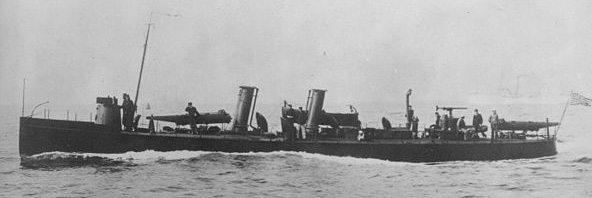
USS MacKenzie.
The two MacKenzie were quite different, 65 tons, same length at 30.94m but larger at a width of 3.89m vs 3.81m. The latter also had a larger draught at 1.29 m vs. 0.99m. For propulsion, they had Thornycroft instead of Normand boilers. Apart from their two funnels and the same three 18 in TTs, they had all a single 1-pdr gun bar the USS McKee had two. They also had two funnels. Both served as target ships, from 1912 (MacKee) and 1916 (MacKenzie).
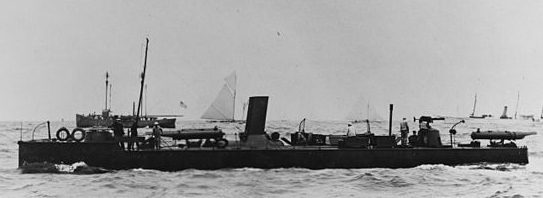
USS Talbot, TB15
Talbot class specifications |
|
| Dimensions | 30.48 x3.81 x0.99 m |
| Displacement | 46t FL |
| Crew | 12 |
| Propulsion | 1 screw, 1 VTE, 2 Normand boilers, 850 ihp |
| Speed | 20 knots (38 km/h; xx mph), coal 9 tons |
| Armament | 2 TT 18 in, 1 x1pdr QF gun. |

USS Foote, illustration by the author
The “medium group” prior to 1898
This was by far the largest, with the USS Cushing, Ericsson, Rowan, Morris, and Somers, and the classes Foote, Porter, Dahlgren, and Davis.
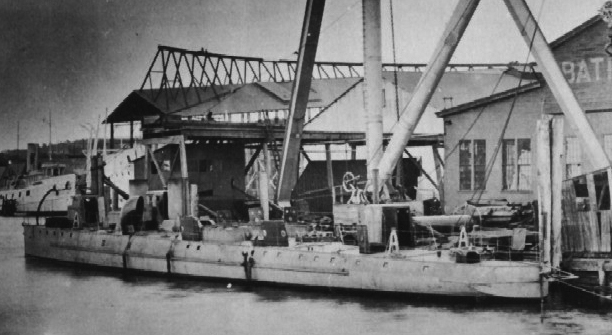
USS Dahlgren, TB9.
USS Cushing
The first official TB commissioned for service was the TB1, built by the same yard after many design revisions. It was laid down in April of 1888, launched in January 1890, and completed in April of the same year. She had two funnels far apart, a ram bow, turtleback (the first US TB to be fitted with such a scheme), two broadside training 18 in TTs, and one fixed forward into the bow. Her armament was heavy, with three 6-pdr guns. The TB1 was sunk as a practice target in 1920.

USS Cushing, starboard side, 1891.
USS Ericsson (1894) was heavier (120 rather than 116 tons), and very similar but for its armament back to three lighter 1-pdr guns. It could reach 24 knots. In 1912 it was used as a target and sunk.
The Foote class (1896) comprised also USS Rodgers and Winslow. They were commissioned in 1897-98. They had two funnels far apart, three TTs on each broadside and a third aft, and three 1-pdr guns. 142 tons, 48.76 m long, and two had Mosher instead of Thornycroft boilers but two shafts for 2000 ihp, and could run at 25 knots. They were sold in 1911-1920.
The Porter class (1896) from Herreschoff were 165 tons, 53.50 m (175 feet) long ships capable of 27.5 knots and armed with four 1-pdr guns. The first was sold in 1912, and the second in 1920.
The Dahlgren class (1899) were 146-ton boats, 46.13 m long (151 feet), with a different armament of four 1-pdr but only two TTs, centerline, aft, and far aft. They had Normand boilers and were the fastest of them all, reaching 30 knots. Details of their superstructure and funnels were also reminiscent of French designs. The Craven ended as a target in 1913, and the Dhalgren served through WW1 before being sold for scrap in 1920.
The Davis class (1898) also comprised the USS Fox (TB-13). These 1550 tons ships had two vertical triple expansion engines, coupled with Thornycroft boilers, and were capable of 23 knots. They had three TTs in the usual disposition. Fox was sold in 1916, the other in 1920 after being decommissioned in 1913.
–USS Rowan was a 182 tons ship authorized under the act of 2.3.1895, and had funnels and TTs arranged like the Porter, but also had a raised forecastle. She was decommissioned in 1912 but only sold in 1918.
–USS Morris was a relatively light TB of 105 tons, 42.35 m (139’6”) long, with two funnels not far apart, and Normand boilers. She was capable of 23 knots and carried the usual armament of three TTs and three 1-pdr guns.
The USS Somers was German built at Schichau, as a private speculation, carried by the steamer SS Manhattan on its way to US waters. She had a single funnel and three masts, two training TTs on the deck, and one submerged TT at the bow. It was 17.5 m (156 feet) long for 143 tons and its locomotive boilers fed a VQE engine which developed 1700 ihp, for 23 knots. Like other TBs in reserve, she was renamed TB N°9 to leave the name for a new destroyer.
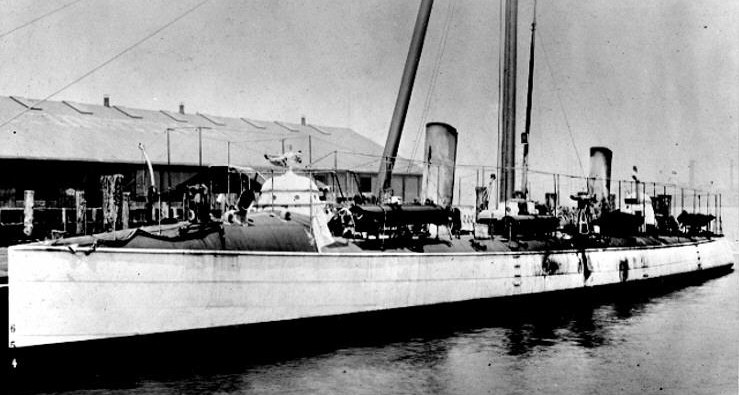
USS Foote.
Post war group: USS Blakeley class
This relatively homogeneous class counted the USS Blakely, USS DeLong, Nicholson, O’Brien, Shubrick, Stockton, Thornton, Tingey, and Wilkes (TB-27-35).
They were assimilated because of the same 04.05.1898 order, but differed as much as their shipyard’s own specs: Their displacement ranged from 165 (Tingey) to 220 tonnes (O’Brien), but all measured 53.35 meters overall and 5.38 m in width (175′ and 17’8”) but with an underwater height of 1.42 to 1.98 m (6’6”).
Their armament was also uniform, with the same three 18-in TTs (port, starboard, far aft) and three 1-pdr QF guns, but three 3-pdr for the Shubrick sub-class (Stockton, Thornton). Their average top speed was 25 knots but Wilkes was the faster of them all, at 27 knots.
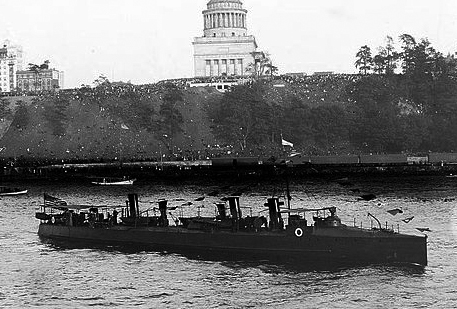
USS Blakeley, TB-27 underway off Grant’s tomb.
Nicholson sub-class specifications |
|
| Dimensions | 53.35 x5.18 x1.96 m |
| Displacement | 218-220 tons FL |
| Crew | 28 |
| Propulsion | 2 screws, 2 shafts VTE, 3 Mosher boilers, 3000 ihp |
| Speed | 25 knots (47 km/h; xx mph), coal 80 tons |
| Armament | 3 TT 18 in, 3 x1pdr QF guns. |
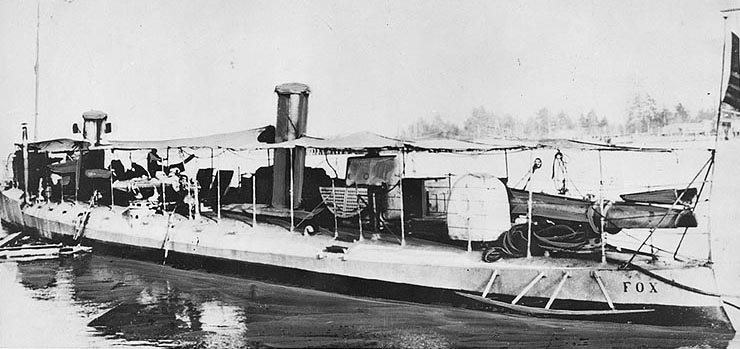
USS Fox, David class (TB-13), 1898.
American TBs in ww1
About 20 were left in service when the war broke out. Some were quickly converted as target ships, and others were just mothballed and played no significant part in the operations bar potentially some coastal patrols.
They were not equipped for ASW warfare in any case. A good example of an “active career” was the USS Tingey (TB-34): She joined the Reserve Torpedo Flotilla (Norfolk Navy Yard), laying tied up at a pier side, doing a few sorties to ensure her operational readiness.
By 1908, she was part of the 3rd Torpedo Flotilla, and next year “the Atlantic Torpedo Fleet”. She moved however late this year to Charleston, S.C., staying in reserve. In 1917, she was sent to the Philadelphia Navy Yard and decommissioned from 8 March to 7 April 1917.
She patrolled the coastal waters of the 1st Naval District and was eventually renamed in September 1918 to “Coastal Torpedo Boat No. 17”, before being decommissioned at Philadelphia on 30 January 1919, struck from the list, and sold. USS Gwin and Morris survived until 1924-25.
Epilogue
Although the story of American TBs before ww1 seems like a footnote, quickly swapping over long-range destroyers instead, there was a revival of the concept in WW2, at the occasion of the Pacific War, shaped as the mass-built “PT boat” from Elco, Higgins and assimilated wooden type Motor torpedo boats, which disrupted Japanese shipping and sunk many military ships.
Gallery
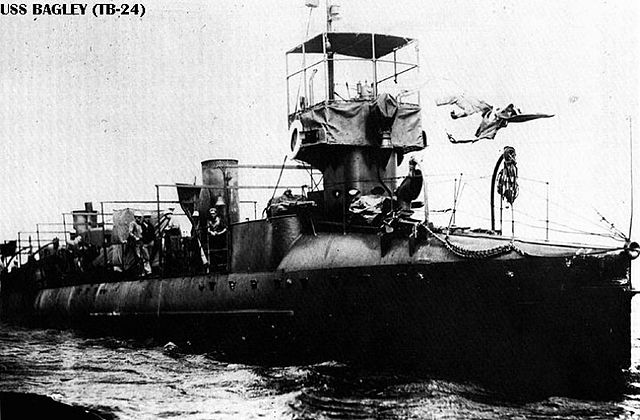
USS Bagley (TB-24), the first to carry a floatplane.
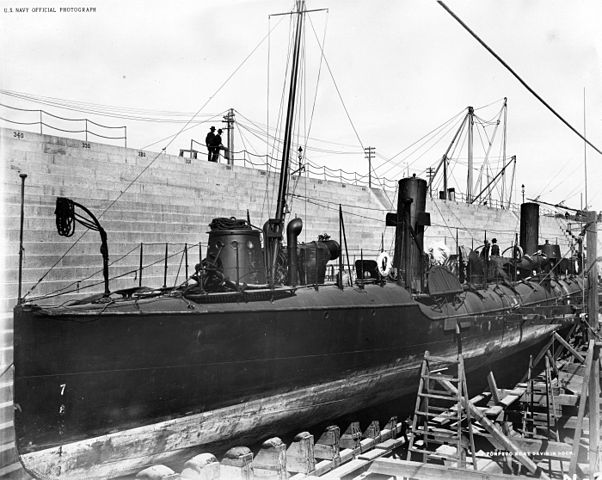
USS Davis (TB-12).
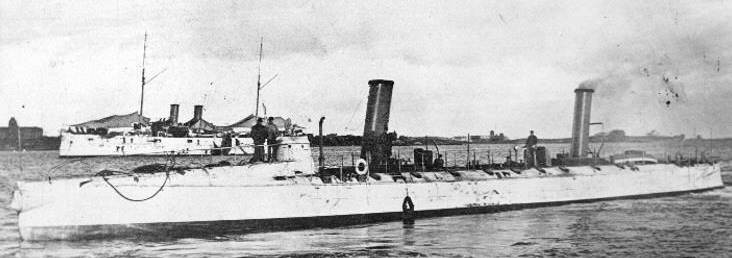
USS Ericsson.
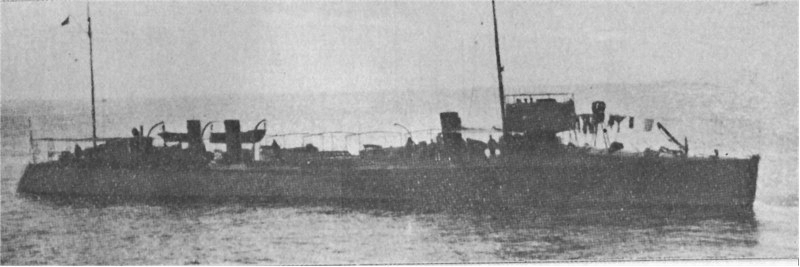
USS Bailey, TB-21.

USS Farragut, TB-11 off Mare Island Navy Yard circa 1899.
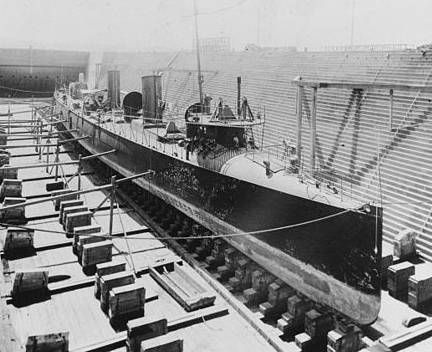
USS Goldsborough, TB-20.
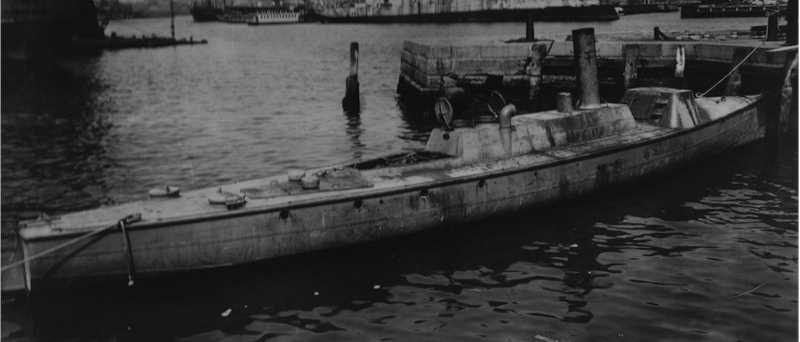
USS Manley (TB-23), mothballed.
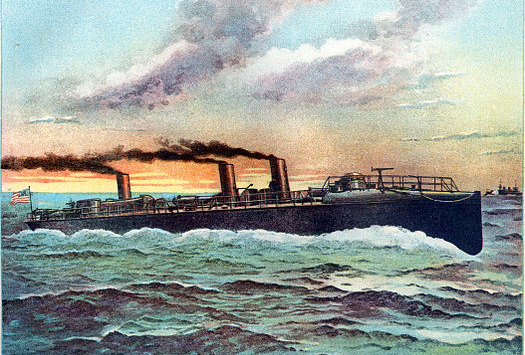
USS Porter (1898).
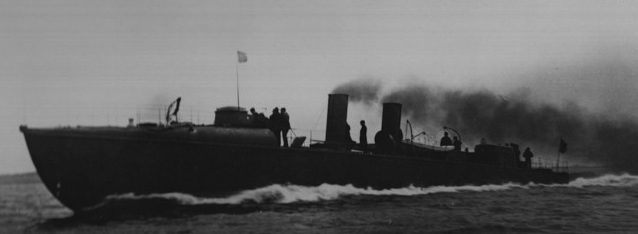
USS Morris, TB-14.

USS Rowan – TB-8.
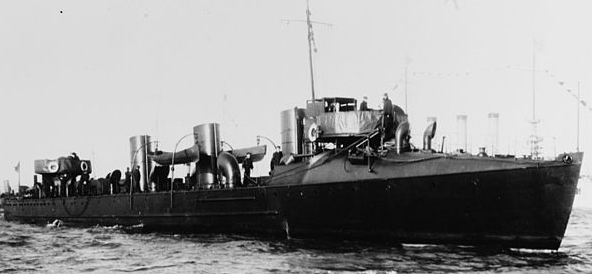
USS Stringham (TB-19).
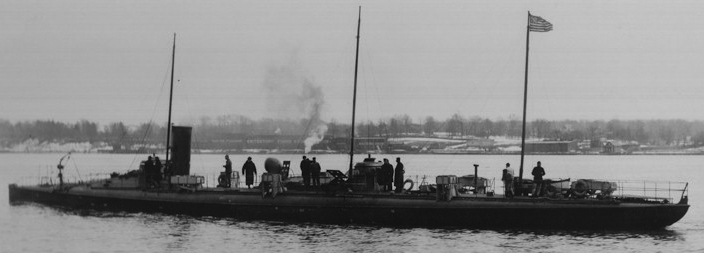
USS Somers (TB-22).
Sources
Conway’s all the world’s fighting ships 1865-1905
www.navweaps.com/Weapons/WTUS_PreWWII.php
www.warboats.org/EarlyPatrolBoats.htm
en.wikipedia.org/wiki/List_of_torpedo_boats_of_the_United_States_Navy
en.wikipedia.org/wiki/Torpedo


 Latest Facebook Entry -
Latest Facebook Entry -  X(Tweeter) Naval Encyclopedia's deck archive
X(Tweeter) Naval Encyclopedia's deck archive Instagram (@navalencyc)
Instagram (@navalencyc)





 French Navy
French Navy Royal Navy
Royal Navy Russian Navy
Russian Navy Armada Espanola
Armada Espanola Austrian Navy
Austrian Navy K.u.K. Kriegsmarine
K.u.K. Kriegsmarine Dansk Marine
Dansk Marine Nautiko Hellenon
Nautiko Hellenon Koninklije Marine 1870
Koninklije Marine 1870 Marinha do Brasil
Marinha do Brasil Osmanlı Donanması
Osmanlı Donanması Marina Do Peru
Marina Do Peru Marinha do Portugal
Marinha do Portugal Regia Marina 1870
Regia Marina 1870 Nihhon Kaigun 1870
Nihhon Kaigun 1870 Preußische Marine 1870
Preußische Marine 1870 Russkiy Flot 1870
Russkiy Flot 1870 Svenska marinen
Svenska marinen Søværnet
Søværnet Union Navy
Union Navy Confederate Navy
Confederate Navy Armada de Argentina
Armada de Argentina Imperial Chinese Navy
Imperial Chinese Navy Marinha do Portugal
Marinha do Portugal Mexico
Mexico Kaiserliche Marine
Kaiserliche Marine 1898 US Navy
1898 US Navy Sovietskiy Flot
Sovietskiy Flot Royal Canadian Navy
Royal Canadian Navy Royal Australian Navy
Royal Australian Navy RNZN Fleet
RNZN Fleet Chinese Navy 1937
Chinese Navy 1937 Kriegsmarine
Kriegsmarine Chilean Navy
Chilean Navy Danish Navy
Danish Navy Finnish Navy
Finnish Navy Hellenic Navy
Hellenic Navy Polish Navy
Polish Navy Romanian Navy
Romanian Navy Turkish Navy
Turkish Navy Royal Yugoslav Navy
Royal Yugoslav Navy Royal Thai Navy
Royal Thai Navy Minor Navies
Minor Navies Albania
Albania Austria
Austria Belgium
Belgium Columbia
Columbia Costa Rica
Costa Rica Cuba
Cuba Czechoslovakia
Czechoslovakia Dominican Republic
Dominican Republic Haiti
Haiti Hungary
Hungary Honduras
Honduras Estonia
Estonia Iceland
Iceland Eire
Eire Equador
Equador Iran
Iran Iraq
Iraq Latvia
Latvia Liberia
Liberia Lithuania
Lithuania Mandchukuo
Mandchukuo Morocco
Morocco Nicaragua
Nicaragua Persia
Persia San Salvador
San Salvador Sarawak
Sarawak Uruguay
Uruguay Venezuela
Venezuela Zanzibar
Zanzibar Warsaw Pact Navies
Warsaw Pact Navies Bulgaria
Bulgaria Hungary
Hungary

 Bundesmarine
Bundesmarine Dutch Navy
Dutch Navy Hellenic Navy
Hellenic Navy Marina Militare
Marina Militare Yugoslav Navy
Yugoslav Navy Chinese Navy
Chinese Navy Indian Navy
Indian Navy Indonesian Navy
Indonesian Navy JMSDF
JMSDF North Korean Navy
North Korean Navy Pakistani Navy
Pakistani Navy Philippines Navy
Philippines Navy ROKN
ROKN Rep. of Singapore Navy
Rep. of Singapore Navy Taiwanese Navy
Taiwanese Navy IDF Navy
IDF Navy Saudi Navy
Saudi Navy Royal New Zealand Navy
Royal New Zealand Navy Egyptian Navy
Egyptian Navy South African Navy
South African Navy






























 Ukrainian Navy
Ukrainian Navy dbodesign
dbodesign